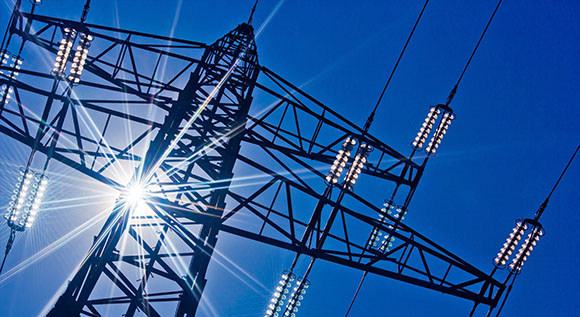An action plan for cross-border trade in electricity
Europe's electricity markets are becoming increasingly more intertwined. This is why, by the end of 2025, 70 per cent of cross-border power lines are to be opened up for international electricity trading. Germany sets out how it will achieve these plans domestically in its Bidding Zone Action Plan.
 © AdobeStock / Gina Sanders
© AdobeStock / Gina Sanders
Germany has long been a hub for European electricity trading. As our electricity markets become more intertwined, the need to transport electricity across the grid is also growing. According to the new EU Electricity Market Regulation, at least 70 per cent of cross-border power lines are now to be progressively opened up for cross-border electricity trading from 1 January 2020. This would mean a sharp increase in most of the limits for cross-border electricity flows between Germany and its neighboring countries. German transmission system operators say this will lead to considerable bottlenecks in Germany's domestic electricity grid, i.e. our electricity grid will become be overloaded. Only about 20 per cent of capacity at Germany's borders with the Netherlands, France and Austria, for example, is currently open. The situation with other European neighbours is similar. According to the transmission system operators, the eastern European countries are 11.5 per cent open, while Sweden has already reached the 41 per cent mark. Some of Denmark's interconnectors already reach the required 70 per cent.
Action plans ensure a transition period up to the end of 2025
Given these challenges for the electricity grid, the EU Electricity Market Regulation grants each Member State a transitional period for expanding its electricity trade. To take advantage of this, the countries must each submit a national action plan setting out what specific measures will be taken to reduce domestic grid bottlenecks. Once an action plan has been submitted, the volume of cross-border trade must rise gradually from that point onwards. However, the target value of 70 per cent must be reached by 31 December 2025 at the latest. Countries including the Netherlands, Poland and Germany have opted to submit such an action plan. Germany submitted its Bidding Zone Action Plan to the European Commission and the Agency for the Cooperation of Energy Regulators (ACER) at the end of 2019. Many other countries are also facing challenges in opening their borders and plan to apply for temporary exemptions from achieving new capacities for cross-border trade. However, Germany is not seeking to do so, as its Action Plan contains specific measures for making the electricity grid fit to handle the increased volumes of electricity as well as timetables for conducting this work. Its Action Plan contains both national measures for developing cross-border cooperation as well as regional initiatives.
Transmission grids to be fortified and expanded
The Action Plan is based around a series of measures designed to reduce grid congestion and improve the what is known as 'redispatch'. A key aim is to strengthen and increase the capacity utilisation of the transmission networks. This crucially involves not only accelerating network expansion, but also optimising existing networks. For example, so-called 'phase shifters' are to be used to better control the flow of electricity in the grid and thus increase its overall transport capacity.
The Bidding Zone Action Plan also focuses on ensuring that overhead lines can operate regardless of what the weather conditions are. This is an issue, as the conductor cable has a maximum operating temperature – imposing a limit on the transmission capacity of the overhead lines. This maximum temperature depends mainly on how high the volume of electricity flow and the air temperature are. By precisely recording the ambient temperatures of and the onflow of wind onto individual lines, the idea is to help determine the maximum permissible current flow and thus increase the overall load on the lines. The use of high-temperature conductor cables also makes it possible to increase the load on the existing network.
Creating a better balance between consumption and production
In order to improve congestion management, the redispatch of electricity must be made more efficient. Power generation and grids need to be better aligned with one another. This is why, as part of the future expansion of renewables, wind power plants are to be increasingly be built in southern Germany, for example. As coal-fired power plants are shut down, the impact on transport capacity needs for electricity will also be considered. Coal-fired power plants that are important for the electricity grid will therefore be excluded from the first call for shutdowns. If there is any doubt as to the impact of a particular shutdown, the power plant is not allowed to stay shut down completely but must remain available to serve as a reserve power plant.
In the second part of the Bidding Zone Action Plan, the principles for calculating the starting values for the Germany's 'minimum trading capacity' are explained. These principles form the basis for the gradual increase to 70 per cent. The Bundesnetzagentur [Federal Network Agency] undertakes comprehensive monitoring to ensure that the transmission system operators also fully implement the requirements for allocating capacities for cross-border electricity transmission.
A uniform bidding zone is to be maintained
The overall objective of the Bidding Zone Action Plan is to maintain a uniform national bidding zone and strengthen cross-border electricity trading. Europe is already divided into several electricity market areas, known as 'price zones' or 'bidding zones'. In each of these zones, a uniform electricity price applies to all. Having uniform bidding zones makes it possible to harness balancing effects in generation and consumption across a geographical area. They also provide easy access to the electricity market not only for large suppliers, but also for small innovative providers as well. Analyses conducted by the transmission system operators also show that the bottlenecks within Germany are distributed across the entire transmission system and therefore – unlike in other countries – do not provide clear geographical boundaries for establishing different bidding zones.

